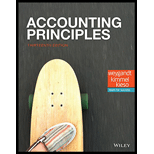
Concept explainers
(a)
Accounting for Receivables:
Receivables are defined as the amounts that are due to a firm by its customers and other parties. Receivables include all those assets that arise due to the primary operations of a firm and those representing cash that is to be collected from all external parties who owe money to the firm.
Receivables are broadly categorized into trade-receivables and non-trade receivables. Trade receivables refer to those receivables that occur due to the sale of goods and services in the normal course of business. Non-trade receivables refer to the amounts that occur due to third parties from transactions outside the primary course of business.
Notes receivable:
Notes receivable can be defined as a written promissory note. It can also be referred to as a note required for collection of interest and is collected within a time period of 60 to 90 days. It is a result of sales transactions.
Promissory note gives the holder a stronger legal claim as compared to
To journalize: The transactions for E. Company.
(b)
To record: The collection of L’s note at its maturity in 2018.
Want to see the full answer?
Check out a sample textbook solution
Chapter 9 Solutions
EBK ACCOUNTING PRINCIPLES
- In September, one of the processing departments at Stratford Corporationhad beginning work in process inventory of $45,000 and ending work in process nventory of $19,000. During the month, the cost of units transferred out fromthe department was $632,000. In the department's cost reconciliation report for September, the total cost to be accounted for under the weighted-average method would be____. Answerarrow_forwardGeneral accountingarrow_forwardWhat is the amount of the operating cash flowarrow_forward
- Please provide answer for this financial accounting problemarrow_forwardBeachside Hotel has sales of $1,250,000 and a profit margin of 10%. The annual depreciation expense is $135,000. What is the amount of the operating cash flow if the company has no long-term debt?arrow_forwardBeachside Hotel has sales of $1,250,000 and a profit margin of 10%. The annual depreciation expense is $135,000. What is the amount of the operating cash flow if the company has no long-term debt? Need answerarrow_forward
- Can you help me solve this general accounting question using the correct accounting procedures?arrow_forwardPlease provide the accurate answer to this general accounting problem using valid techniques.arrow_forwardCan you explain this general accounting question using accurate calculation methods?arrow_forward

 AccountingAccountingISBN:9781337272094Author:WARREN, Carl S., Reeve, James M., Duchac, Jonathan E.Publisher:Cengage Learning,
AccountingAccountingISBN:9781337272094Author:WARREN, Carl S., Reeve, James M., Duchac, Jonathan E.Publisher:Cengage Learning, Accounting Information SystemsAccountingISBN:9781337619202Author:Hall, James A.Publisher:Cengage Learning,
Accounting Information SystemsAccountingISBN:9781337619202Author:Hall, James A.Publisher:Cengage Learning, Horngren's Cost Accounting: A Managerial Emphasis...AccountingISBN:9780134475585Author:Srikant M. Datar, Madhav V. RajanPublisher:PEARSON
Horngren's Cost Accounting: A Managerial Emphasis...AccountingISBN:9780134475585Author:Srikant M. Datar, Madhav V. RajanPublisher:PEARSON Intermediate AccountingAccountingISBN:9781259722660Author:J. David Spiceland, Mark W. Nelson, Wayne M ThomasPublisher:McGraw-Hill Education
Intermediate AccountingAccountingISBN:9781259722660Author:J. David Spiceland, Mark W. Nelson, Wayne M ThomasPublisher:McGraw-Hill Education Financial and Managerial AccountingAccountingISBN:9781259726705Author:John J Wild, Ken W. Shaw, Barbara Chiappetta Fundamental Accounting PrinciplesPublisher:McGraw-Hill Education
Financial and Managerial AccountingAccountingISBN:9781259726705Author:John J Wild, Ken W. Shaw, Barbara Chiappetta Fundamental Accounting PrinciplesPublisher:McGraw-Hill Education





